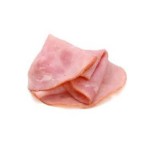Deli ham is a popular and versatile processed meat product, typically sold pre-sliced at the delicatessen counter or pre-packaged in the refrigerated section of grocery stores. Here's a description of what you can generally expect:
Appearance: Deli ham usually comes in thin, even slices, showcasing its pink to reddish-pink color. The texture appears smooth and slightly moist. Depending on the type, you might see subtle variations in color and marbling. Some varieties might have a darker outer edge from smoking or a visible fat cap.
Texture: It has a tender and slightly chewy texture. High-quality deli ham is moist and easy to bite, while some lower-quality options might be a bit tougher or more processed in feel.
Taste: The flavor is typically savory and slightly salty, a result of the curing process. Depending on the specific type, you might detect notes of sweetness (as in honey ham), smokiness (as in Black Forest ham), or a more pronounced pork flavor. The level of seasoning can also vary between brands.
Processing: Deli ham is made from cuts of pork leg that have been cured with salt, nitrates or nitrites, and often sugar and various spices. It's then typically cooked and sometimes smoked. The specific curing and cooking methods contribute significantly to the final taste and texture.
Varieties: There's a wide range of deli ham available, including:
- Honey Ham: Sweetened with honey during the curing or cooking process.
- Smoked Ham: подвергается копчению для придания характерного аромата.
- Black Forest Ham: A dry-cured and heavily smoked variety with a distinct flavor.
- Virginia Ham: A dry-cured ham with a salty and intense flavor.
- Boiled Ham: A milder, less salty variety that is simply cooked.
- Low-Sodium Ham: Processed to contain less sodium than traditional deli ham.
Common Uses: Deli ham is incredibly versatile and used in numerous ways:
- Sandwiches and Wraps: A classic filling for quick and easy meals.
- Salads: Diced or sliced and added to green salads or pasta salads.
- Charcuterie Boards: Often included as part of a selection of cured meats and cheeses.
- Breakfast Dishes: Added to omelets, frittatas, or breakfast sandwiches.
- Snacks: Sometimes eaten on its own as a protein-rich snack.

